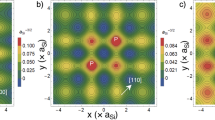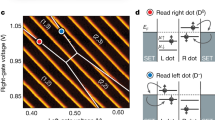Abstract
Electron spins confined to phosphorus donors in silicon are promising candidates as qubits1 because of their long coherence times, exceeding seconds in isotopically purified bulk silicon2. With the recent demonstrations of initialization, readout3 and coherent manipulation4 of individual donor electron spins, the next challenge towards the realization of a Si:P donor-based quantum computer is the demonstration of exchange coupling1,5,6 in two tunnel-coupled phosphorus donors. Spin-to-charge conversion3,7 via Pauli spin blockade8,9, an essential ingredient for reading out individual spin states, is challenging in donor-based systems due to the inherently large donor charging energies (∼45 meV), requiring large electric fields (>1 MV m–1) to transfer both electron spins onto the same donor10. Here, in a carefully characterized double donor-dot device, we directly observe spin blockade of the first few electrons and measure the effective exchange interaction between electron spins in coupled Coulomb-confined systems.
This is a preview of subscription content, access via your institution
Access options
Subscribe to this journal
Receive 12 print issues and online access
$259.00 per year
only $21.58 per issue
Buy this article
- Purchase on Springer Link
- Instant access to full article PDF
Prices may be subject to local taxes which are calculated during checkout




Similar content being viewed by others
References
Kane, B. E. A silicon-based nuclear spin quantum computer. Nature 393, 133–137 (1998).
Tyryshkin, A. M. et al. Electron spin coherence exceeding seconds in high-purity silicon. Nature Mater. 11, 143–147 (2012).
Morello, A. et al. Single-shot readout of an electron spin in silicon. Nature 467, 687–691 (2010).
Pla, J. J. et al. A single-atom electron spin qubit in silicon. Nature 489, 541–545 (2012).
Koiller, B., Hu, X. & Das Sarma, S. Exchange in silicon-based quantum computer architecture. Phys. Rev. Lett. 88, 027903 (2001).
Wellard, C. J. et al. Electron exchange coupling for single-donor solid-state spin qubits. Phys. Rev. B 68, 195209 (2003).
Petta, J. R. et al. Coherent manipulation of coupled electron spins in semiconductor quantum dots. Science 309, 2180–2184 (2005).
Ono, K., Austing, D. G., Tokura, Y. & Tarucha, S. Current rectification by Pauli exclusion in a weakly coupled double quantum dot system. Science 297, 1313–1317 (2002).
Johnson, A. C., Petta, J. R., Marcus, C. M., Hanson, M. P. & Gossard, A. C. Singlet-triplet spin blockade and charge sensing in a few-electron double quantum dot. Phys. Rev. B 72, 165308 (2005).
Fang, A., Chang, Y. C. & Tucker, J. R. Effects of J-gate potential and uniform electric field on a coupled donor pair in Si for quantum computing. Phys. Rev. B 66, 155331 (2002).
Hollenberg, L. C. L., Greentree, A. D., Fowler, A. G. & Wellard, C. J. Two-dimensional architectures for donor-based quantum computing. Phys. Rev. B 74, 045311 (2006).
Büch, H., Mahapatra, S., Rahman, R., Morello, A. & Simmons, M. Y. Spin readout and addressability of phosphorus-donor clusters in silicon. Nature Commun. 4, 2017 (2013).
Weber, B., Mahapatra, S., Watson, T. F. & Simmons, M. Y. Engineering independent electrostatic control of atomic-scale (∼4 nm) silicon double quantum dots. Nano Lett. 12, 4001–4006 (2012).
Greentree, A. D., Cole, J. H., Hamilton, A. R. & Hollenberg, L. C. L. Coherent electronic transfer in quantum dot systems using adiabatic passage. Phys. Rev. B 70, 235317 (2004).
Bose, S. Quantum communication through spin chain dynamics: an introductory overview. Contemp. Phys. 48, 13 (2007).
Skinner, A. J., Davenport, M. E. & Kane, B. E. Hydrogenic spin quantum computing in silicon: a digital approach. Phys. Rev. Lett. 90, 087901 (2003).
Shaji, N. et al. Spin blockade and lifetime-enhanced transport in a few-electron Si/SiGe double quantum dot. Nature Phys. 4, 540–544 (2008).
Borselli, M. G. et al. Measurement of valley splitting in high-symmetry Si/SiGe quantum dots. Appl. Phys. Lett. 98, 123118 (2011).
Roche, B. et al. Detection of a large valley-orbit splitting in silicon with two-donor spectroscopy. Phys. Rev. Lett. 108, 206812 (2012).
Dupont-Ferrier, E. et al. Coherent coupling of two dopants in a silicon nanowire probed by Landau-Zener-Stückelberg interferometry. Phys. Rev. Lett. 110, 136802 (2013).
Warschkow, O. et al. Phosphine adsorption and dissociation on the Si(001) surface: An ab initio survey of structures. Phys. Rev. B 72, 125328 (2005).
Weber, B. et al. Ohm's law survives to the atomic scale. Science 335, 64–67 (2012).
Fuhrer, A. et al. Few electron double quantum dots in InAs/InP nanowire heterostructures. Nano Lett. 7, 243–246 (2006).
Klimeck, G. et al. Atomistic simulation of realistically sized nanodevices using NEMO 3-D – part I: models and benchmarks. IEEE Trans. Electron. Dev. 54, 2079–2089 (2007).
Rahman, R. et al. High precision quantum control of single donor spins in silicon. Phys. Rev. Lett. 99, 036403 (2007).
Fuechsle, M. et al. A single-atom transistor. Nature Nanotech. 7, 242–246 (2012).
Hada, Y. & Eto, M. Electronic states in silicon quantum dots: multivalley artificial atoms. Phys. Rev. B 68, 155322 (2003).
Lim, W. H., Yang, C. H., Zwanenburg, F. A. & Dzurak, A. S. Spin filling of valley-orbit states in a silicon quantum dot. Nanotechnology 22, 335704 (2011).
Nazarov, Y. V. Quantum interference, tunnel junctions and resonant tunneling interferometer. Physica B 189, 57 (1993).
Badrutdinov, A., Huang, S., Kono, K., Ono, K. & Tayurskii, D. Cotunneling effects in GaAs vertical double quantum dots. JETP Lett. 93, 199–202 (2011).
Acknowledgements
This research was conducted by the Australian Research Council Centre of Excellence for Quantum Computation and Communication Technology (project no. CE110001027) and the US National Security Agency and US Army Research Office (contract no. W911NF-08-1-0527). Computational resources on nanoHUB.org, funded by the National Science Foundation (grant no. EEC-0228390), were used extensively. M.Y.S. acknowledges an ARC Laureate Fellowship.
Author information
Authors and Affiliations
Contributions
B.W. and T.F.W. carried out the fabrication. B.W. performed measurements. B.W., Y.H.M.T., S.M., T.F.W., H.R., R.R., L.H., G.K. and M.Y.S. analysed the data. Y.H.M.T., H.R. and R.R. carried out the calculations. M.Y.S. planned the project. G.K. planned the theoretical modelling approach. B.W. and M.Y.S. prepared the manuscript.
Corresponding author
Ethics declarations
Competing interests
The authors declare no competing financial interests.
Supplementary information
Supplementary information
Supplementary information (PDF 723 kb)
Rights and permissions
About this article
Cite this article
Weber, B., Tan, Y., Mahapatra, S. et al. Spin blockade and exchange in Coulomb-confined silicon double quantum dots. Nature Nanotech 9, 430–435 (2014). https://doi.org/10.1038/nnano.2014.63
Received:
Accepted:
Published:
Issue Date:
DOI: https://doi.org/10.1038/nnano.2014.63
This article is cited by
-
EUV-induced hydrogen desorption as a step towards large-scale silicon quantum device patterning
Nature Communications (2024)
-
A solid-state quantum microscope for wavefunction control of an atom-based quantum dot device in silicon
Nature Electronics (2023)
-
Qubit-controlled directional edge states in waveguide QED
npj Quantum Information (2023)
-
Optimisation of electron spin qubits in electrically driven multi-donor quantum dots
npj Quantum Information (2022)
-
Experimental realization of an extended Fermi-Hubbard model using a 2D lattice of dopant-based quantum dots
Nature Communications (2022)



